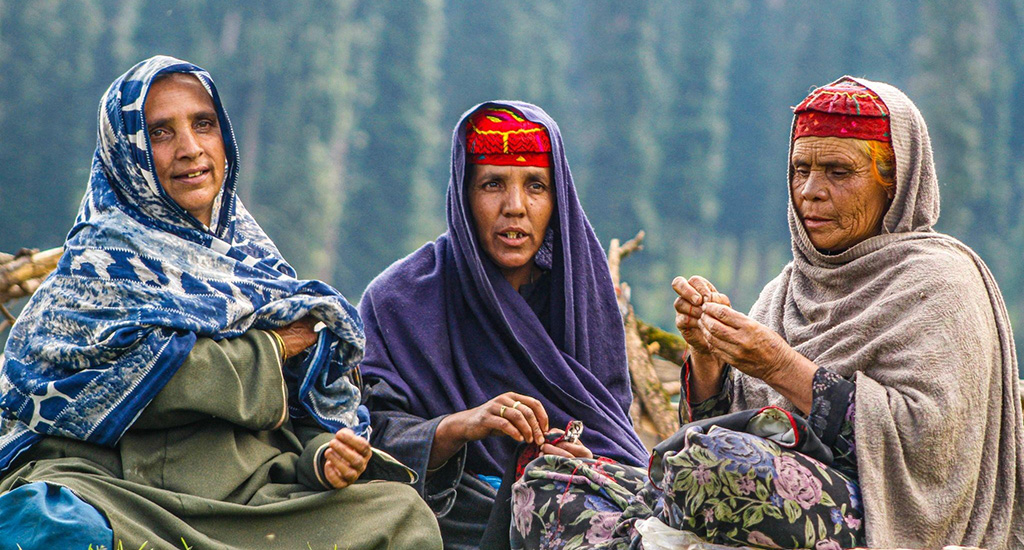With grassy meadows encircled by tall trees as far as the eyes can see, Nimblan in the Pulwama district of Jammu & Kashmir is a picture perfect village.
And in the pleasant weather it’s no wonder 65-year-old Zulaikha sits on the grass in front of her kotah (mud and wood house) in the afternoon hours, busy in stitching a skullcap.
For it’s not every day that she gets an order for a skullcap – that too from a man who lives nearly 150 km from her village.
Though Zulaikha does not earn as much as she used to, she is happy for any orders to stitch skullcaps. It is work that gives her hope the tradition of making skullcups will continue for a while.
Gujjar women’s skullcap – a cultural and religious identity
The major ethnic communities living in Jammu and Kashmir all have their own distinct attire from Kashmiris to Gujjars, Bakerwal, Pahari and Dogras.

Women from the Gujjar and Bakerwal communities, which form the third largest ethnic group in the region, stand out. They wear traditional caps that are totally different from ordinary skullcaps.
Stitched from a piece of cloth, the cap – locally known as topi – is then embroidered with colourful threads, similar to the one Zulaikha was embellishing with simple designs.
“Whether it’s young girls below 10 or older women above 80, women have been wearing topi as a representation of our tradition and culture. It covers our hair too, which is also important in our religion,” said Zulaikha, who is a Muslim.
About three decades ago making skullcaps, mostly for the women of affluent families, was common among the Gujjars. But times are changing.
Changing trends, disappearing tradition
Zulaikha, who has been making these skullcaps since she was 18, has observed their traditions and traditional attire disappearing, especially in the last decade.
“There was a time when women in every household were busy making these skullcaps,” she said, even as her fingers deftly embroidered the cap. “The tradition is now vanishing slowly.”
Also Read | Rajasthani women stitch their way to high fashion
She attributed the change to global fashion trends that are attracting younger people.

True to her words, many young girls from her village did not have their hair covered by a topi, yet were reluctant to say why.
They are impressed by the contemporary fashion, according to Shazia Choudhary, a national television anchor who continues to wear the topi even while on TV.
The young girls are of the view that society will discriminate against them on the basis of wearing old-fashioned skullcaps
“The young girls are of the view that society will discriminate against them on the basis of wearing old-fashioned skullcaps,” she told Village Square.
Diminishing income
The change in fashion is affecting the household incomes of women of Nimblan.
“I wish I could earn the same amount of money making these skullcaps that I earned in my twenties,” said Zulaikha with a sigh.
Her neighbours Suraiya and Saleema, who have been making skullcaps for decades, agreed.
Earlier the women were constantly making these skullcaps that there was an abundant stock and a buyer could pick the colours of her choice. Now that the orders are so few and far between the women make caps only after they get an order. So they make caps of fabric and colours as specified by their customers.
Also Read | Green thumb gives Kashmiri woman financial freedom
A decade ago, a Gujjar woman could earn Rs 5,000 to 7,000 per month – which was quite sufficient for the community in these villages. But now they earn a maximum of Rs 3,000, which is not often.
Towards keeping the tradition alive
The Gujjar women who continue to make the skullcaps said that the women of their community must wear the caps again to continue the tradition.

The women suggested that the administration should conduct cultural programmes – both locally and across the country – so that people would appreciate their rich tradition.
“Though the government authorities and NGOs claim that they’re making efforts to save traditional culture, nothing has been done for our community,” Showkat Ahmad, a Gujjar social activist, told Village Square.
Danish Ali Tedwa, president of Gujjar and Bakerwal Youth Welfare, Pulwama, said that the community as well as the administration should work to revive the traditional topi.
Also Read | A young woman engineer spurs hope for pottery in Kashmir
“Government must organise cultural programmes so that the younger generation develops an interest towards our traditional attire,” said Tedwa.
Perhaps fashion designers could make it an accessory in haute couture to revive the traditional women’s skullcaps of the Gujjars and Bakherwals.
The lead image shows topi-wearing Gujjar women making skullcaps.
Rayees Ramzan is a journalist based in Budgam.








